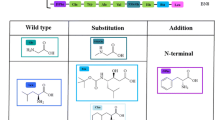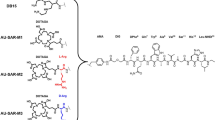Abstract
Purpose
Gastrin-releasing peptide receptors (GRPR) represent attractive targets for tumor diagnosis and therapy because of their overexpression in major human cancers. Internalizing GRPR agonists were initially proposed for prolonged lesion retention, but a shift of paradigm to GRPR antagonists has recently been made. Surprisingly, radioantagonists, such as [99mTc]DB1 (99mTc-N4′-DPhe6,Leu-NHEt13]BBN(6–13)), displayed better pharmacokinetics than radioagonists, in addition to their higher inherent biosafety. We introduce here [68Ga]SB3, a [99mTc]DB1 mimic-carrying, instead of the 99mTc-binding tetraamine, the chelator DOTA for labeling with the PET radiometal 68Ga.
Methods
Competition binding assays of SB3 and [natGa]SB3 were conducted against [125I-Tyr4]BBN in PC-3 cell membranes. Blood samples collected 5 min postinjection (pi) of the [67Ga]SB3 surrogate in mice were analyzed using high-performance liquid chromatography (HPLC) for degradation products. Likewise, biodistribution was performed after injection of [67Ga]SB3 (37 kBq, 100 μL, 10 pmol peptide) in severe combined immunodeficiency (SCID) mice bearing PC-3 xenografts. Eventually, [68Ga]SB3 (283 ± 91 MBq, 23 ± 7 nmol) was injected into 17 patients with breast (8) and prostate (9) cancer. All patients had disseminated disease and had received previous therapies. PET/CT fusion images were acquired 60–115 min pi.
Results
SB3 and [natGa]SB3 bound to the human GRPR with high affinity (IC50: 4.6 ± 0.5 nM and 1.5 ± 0.3 nM, respectively). [67Ga]SB3 displayed good in vivo stability (>85 % intact at 5 min pi). [67Ga]SB3 showed high, GRPR-specific and prolonged retention in PC-3 xenografts (33.1 ± 3.9%ID/g at 1 h pi – 27.0 ± 0.9%ID/g at 24 h pi), but much faster clearance from the GRPR-rich pancreas (≈160%ID/g at 1 h pi to <17%ID/g at 24 h pi) in mice. In patients, [68Ga]SB3 elicited no adverse effects and clearly visualized cancer lesions. Thus, 4 out of 8 (50 %) breast cancer and 5 out of 9 (55 %) prostate cancer patients showed pathological uptake on PET/CT with [68Ga]SB3.
Conclusion
[67Ga]SB3 showed excellent pharmacokinetics in PC-3 tumor-bearing mice, while [68Ga]SB3 PET/CT visualized lesions in about 50 % of patients with advanced and metastasized prostate and breast cancer. We expect imaging with [68Ga]SB3 to be superior in patients with primary breast or prostate cancer.







Similar content being viewed by others
References
Siegel R, Naishadham D, Jemal A. Cancer statistics, 2012. CA Cancer J Clin. 2012;62:10–29. doi:10.3322/caac.20138.
DeSantis C, Siegel R, Bandi P, Jemal A. Breast cancer statistics, 2011. CA Cancer J Clin. 2011;61:409–18. doi:10.3322/caac.20134.
Roehl KA, Antenor JA, Catalona WJ. Serial biopsy results in prostate cancer screening study. J Urol. 2002;167:2435–9.
Elter M, Schulz-Wendtland R, Wittenberg T. The prediction of breast cancer biopsy outcomes using two CAD approaches that both emphasize an intelligible decision process. Med Phys. 2007;34:4164–72.
Hricak H, Choyke PL, Eberhardt SC, Leibel SA, Scardino PT. Imaging prostate cancer: a multidisciplinary perspective. Radiology. 2007;243:28–53. doi:10.1148/radiol.2431030580.
Berg WA, Gutierrez L, NessAiver MS, Carter WB, Bhargavan M, Lewis RS, et al. Diagnostic accuracy of mammography, clinical examination, US, and MR imaging in preoperative assessment of breast cancer. Radiology. 2004;233:830–49. doi:10.1148/radiol.2333031484.
Jadvar H. Imaging evaluation of prostate cancer with 18F-fluorodeoxyglucose PET/CT: utility and limitations. Eur J Nucl Med Mol Imaging. 2013;40 (Suppl 1):S5–10. doi:10.1007/s00259-013-2361-7.
Escalona S, Blasco JA, Reza MM, Andradas E, Gomez N. A systematic review of FDG-PET in breast cancer. Med Oncol. 2010;27:114–29. doi:10.1007/s12032-009-9182-3.
Markwalder R, Reubi JC. Gastrin-releasing peptide receptors in the human prostate: relation to neoplastic transformation. Cancer Res. 1999;59:1152–9.
Körner M, Waser B, Rehmann R, Reubi JC. Early over-expression of GRP receptors in prostatic carcinogenesis. Prostate. 2014;74:217–24. doi:10.1002/pros.22743.
Beer M, Montani M, Gerhardt J, Wild PJ, Hany TF, Hermanns T, et al. Profiling gastrin-releasing peptide receptor in prostate tissues: clinical implications and molecular correlates. Prostate. 2012;72:318–25. doi:10.1002/pros.21434.
Schroeder RP, de Visser M, van Weerden WM, de Ridder CM, Reneman S, Melis M, et al. Androgen-regulated gastrin-releasing peptide receptor expression in androgen-dependent human prostate tumor xenografts. Int J Cancer. 2010;126:2826–34. doi:10.1002/ijc.25000.
Mather SJ, Nock BA, Maina T, Gibson V, Ellison D, Murray I, et al. GRP receptor imaging of prostate cancer using [99mTc]Demobesin 4: a first-in-man study. Mol Imaging Biol. 2014;16:888–95. doi:10.1007/s11307-014-0754-z.
Gugger M, Reubi JC. Gastrin-releasing peptide receptors in non-neoplastic and neoplastic human breast. Am J Pathol. 1999;155:2067–76. doi:10.1016/S0002-9440(10)65525-3.
Reubi C, Gugger M, Waser B. Co-expressed peptide receptors in breast cancer as a molecular basis for in vivo multireceptor tumour targeting. Eur J Nucl Med Mol Imaging. 2002;29:855–62. doi:10.1007/s00259-002-0794-5.
Halmos G, Wittliff JL, Schally AV. Characterization of bombesin/gastrin-releasing peptide receptors in human breast cancer and their relationship to steroid receptor expression. Cancer Res. 1995;55:280–7.
Maina T, Nock B, Mather S. Targeting prostate cancer with radiolabelled bombesins. Cancer Imaging. 2006;6:153–7. doi:10.1102/1470-7330.2006.0025.
Yu Z, Ananias HJ, Carlucci G, Hoving HD, Helfrich W, Dierckx RA, et al. An update of radiolabeled bombesin analogs for gastrin-releasing peptide receptor targeting. Curr Pharm Des. 2013;19:3329–41.
Cescato R, Maina T, Nock B, Nikolopoulou A, Charalambidis D, Piccand V, et al. Bombesin receptor antagonists may be preferable to agonists for tumor targeting. J Nucl Med. 2008;49:318–26. doi:10.2967/jnumed.107.045054.
Mansi R, Wang X, Forrer F, Kneifel S, Tamma ML, Waser B, et al. Evaluation of a 1,4,7,10-tetraazacyclododecane-1,4,7,10-tetraacetic acid-conjugated bombesin-based radioantagonist for the labeling with single-photon emission computed tomography, positron emission tomography, and therapeutic radionuclides. Clin Cancer Res. 2009;15:5240–9. doi:10.1158/1078-0432.CCR-08-3145.
Bodei L, Ferrari M, Nunn A, Llull J, Cremonesi M, Martano L, et al. 177Lu-AMBA bombesin analogue in hormone refractory prostate cancer patients: a phase I escalation study with single-cycle administrations. Eur J Nucl Med Mol Imaging. 2007;34:S221.
Reile H, Armatis PE, Schally AV. Characterization of high-affinity receptors for bombesin/gastrin releasing peptide on the human prostate cancer cell lines PC-3 and DU-145: internalization of receptor bound 125I-(Tyr4)bombesin by tumor cells. Prostate. 1994;25:29–38.
Nock BA, Nikolopoulou A, Galanis A, Cordopatis P, Waser B, Reubi JC, et al. Potent bombesin-like peptides for GRP-receptor targeting of tumors with 99mTc: a preclinical study. J Med Chem. 2005;48:100–10. doi:10.1021/jm049437y.
Marsouvanidis PJ, Nock BA, Hajjaj B, Fehrentz JA, Brunel L, M'Kadmi C, et al. Gastrin releasing peptide receptor-directed radioligands based on a bombesin antagonist: synthesis, 111In-labeling, and preclinical profile. J Med Chem. 2013;56:2374–84. doi:10.1021/jm301692p.
Marsouvanidis PJ, Maina T, Sallegger W, Krenning EP, de Jong M, Nock BA. Tumor diagnosis with new 111In-radioligands based on truncated human gastrin releasing peptide sequences: synthesis and preclinical comparison. J Med Chem. 2013;56:8579–87. doi:10.1021/jm4010237.
Nock BA, Maina T, Krenning EP, de Jong M. “To serve and protect”: enzyme inhibitors as radiopeptide escorts promote tumor targeting. J Nucl Med. 2014;55:121–7. doi:10.2967/jnumed.113.129411.
Baum RP, Prasad V, Frischknecht M, Maecke H, Reubi J. Bombesin receptor imaging in various tumors: first results of Ga-68 AMBA PET/CT. Eur J Nucl Med Mol Imaging. 2007;34:S193-S.
Linder KE, Metcalfe E, Arunachalam T, Chen J, Eaton SM, Feng W, et al. In vitro and in vivo metabolism of Lu-AMBA, a GRP-receptor binding compound, and the synthesis and characterization of its metabolites. Bioconjug Chem. 2009;20:1171–8. doi:10.1021/bc9000189.
Wieser G, Mansi R, Grosu AL, Schultze-Seemann W, Dumont-Walter RA, Meyer PT, et al. Positron emission tomography (PET) imaging of prostate cancer with a gastrin releasing peptide receptor antagonist—from mice to men. Theranostics. 2014;4:412–9. doi:10.7150/thno.7324.
Kähkönen E, Jambor I, Kemppainen J, Lehtio K, Gronroos TJ, Kuisma A, et al. In vivo imaging of prostate cancer using [68Ga]-labeled bombesin analog BAY86-7548. Clin Cancer Res. 2013;19:5434–43. doi:10.1158/1078-0432.CCR-12-3490.
Van de Wiele C, Phonteyne P, Pauwels P, Goethals I, Van den Broecke R, Cocquyt V, et al. Gastrin-releasing peptide receptor imaging in human breast carcinoma versus immunohistochemistry. J Nucl Med. 2008;49:260–4. doi:10.2967/jnumed.107.047167.
Shariati F, Aryana K, Fattahi A, Forghani MN, Azarian A, Zakavi SR, et al. Diagnostic value of 99mTc-bombesin scintigraphy for differentiation of malignant from benign breast lesions. Nucl Med Commun. 2014;35:620–5. doi:10.1097/MNM.0000000000000112.
Scopinaro F, Di Santo GP, Tofani A, Massari R, Trotta C, Ragone M, et al. Fast cancer uptake of 99mTc-labelled bombesin (99mTc BN1). In Vivo. 2005;19:1071–6.
Dalm SU, Martens JW, Sieuwerts AM, van Deurzen CH, Koelewijn SJ, de Blois E, et al. In-vitro and in-vivo application of radiolabeled gastrin releasing peptide receptor ligands in breast cancer. J Nucl Med. 2015;56:752–7. doi:10.2967/jnumed.114.153023.
Prignon A, Nataf V, Provost C, Cagnolini A, Montravers F, Gruaz-Guyon A, et al. 68Ga-AMBA and 18F-FDG for preclinical PET imaging of breast cancer: effect of tamoxifen treatment on tracer uptake by tumor. Nucl Med Biol. 2015;42:92–8. doi:10.1016/j.nucmedbio.2014.10.003.
Beheshti M, Imamovic L, Broinger G, Vali R, Waldenberger P, Stoiber F, et al. 18F choline PET/CT in the preoperative staging of prostate cancer in patients with intermediate or high risk of extracapsular disease: a prospective study of 130 patients. Radiology. 2010;254:925–33. doi:10.1148/radiol.09090413.
Kitajima K, Murphy RC, Nathan MA. Choline PET/CT for imaging prostate cancer: an update. Ann Nucl Med. 2013;27:581–91. doi:10.1007/s12149-013-0731-7.
Silver DA, Pellicer I, Fair WR, Heston WD, Cordon-Cardo C. Prostate-specific membrane antigen expression in normal and malignant human tissues. Clin Cancer Res. 1997;3:81–5.
Wright Jr GL, Grob BM, Haley C, Grossman K, Newhall K, Petrylak D, et al. Upregulation of prostate-specific membrane antigen after androgen-deprivation therapy. Urology. 1996;48:326–34.
Ristau BT, O'Keefe DS, Bacich DJ. The prostate-specific membrane antigen: lessons and current clinical implications from 20 years of research. Urol Oncol. 2014;32:272–9. doi:10.1016/j.urolonc.2013.09.003.
Author information
Authors and Affiliations
Corresponding author
Ethics declarations
Conflicts of interest
None.
Ethical approval
All applicable international, national, and/or institutional guidelines for the care and use of animals were followed.
All procedures performed in studies involving human participants were in accordance with the ethical standards of the institutional and/or national research committee and with the 1964 Declaration of Helsinki and its later amendments or comparable ethical standards.
Informed consent
Informed consent was obtained from all individual participants included in the study.
Additional information
Theodosia Maina and Hendrik Bergsma contributed equally to this work
Electronic supplementary material
Below is the link to the electronic supplementary material.
ESM 1
(PDF 482 kb)
Glossary
- [99mTc]DB1
-
99mTc-(N′4)-DPhe-Gln-Trp-Ala-Val-Gly-His-Leu-NHEt)
- [99mTc]DB4
-
99mTc-N4-Pro-Gln-Arg-Tyr-Gly-Asn-Gln-Trp-Ala-Val-Gly-His-Leu-Nle-NH2
- DOTA
-
1,4,7,10-tetraazacyclododecane-1,4,7,10-tetraacetic acid
Rights and permissions
About this article
Cite this article
Maina, T., Bergsma, H., Kulkarni, H.R. et al. Preclinical and first clinical experience with the gastrin-releasing peptide receptor-antagonist [68Ga]SB3 and PET/CT. Eur J Nucl Med Mol Imaging 43, 964–973 (2016). https://doi.org/10.1007/s00259-015-3232-1
Received:
Accepted:
Published:
Issue Date:
DOI: https://doi.org/10.1007/s00259-015-3232-1




